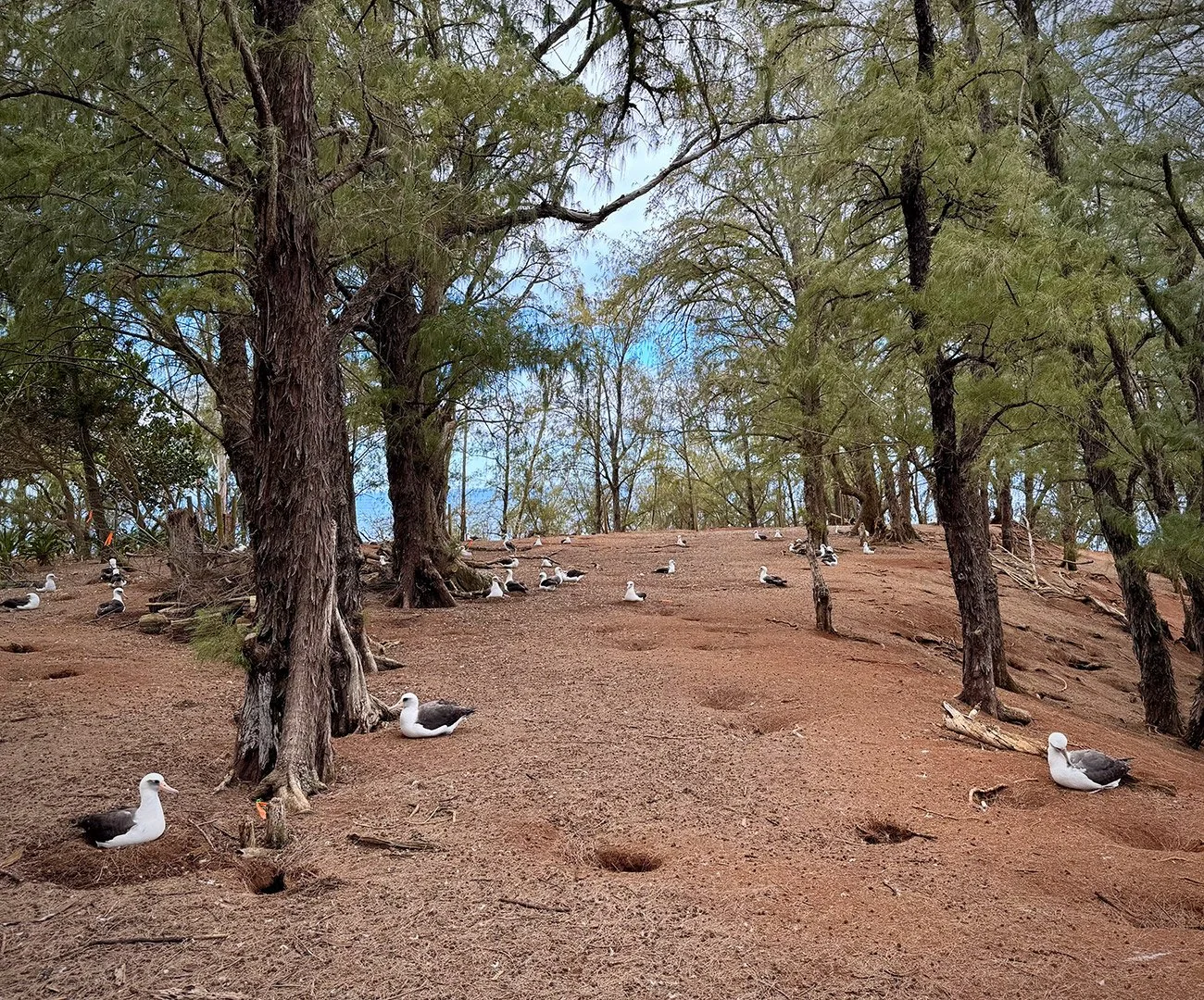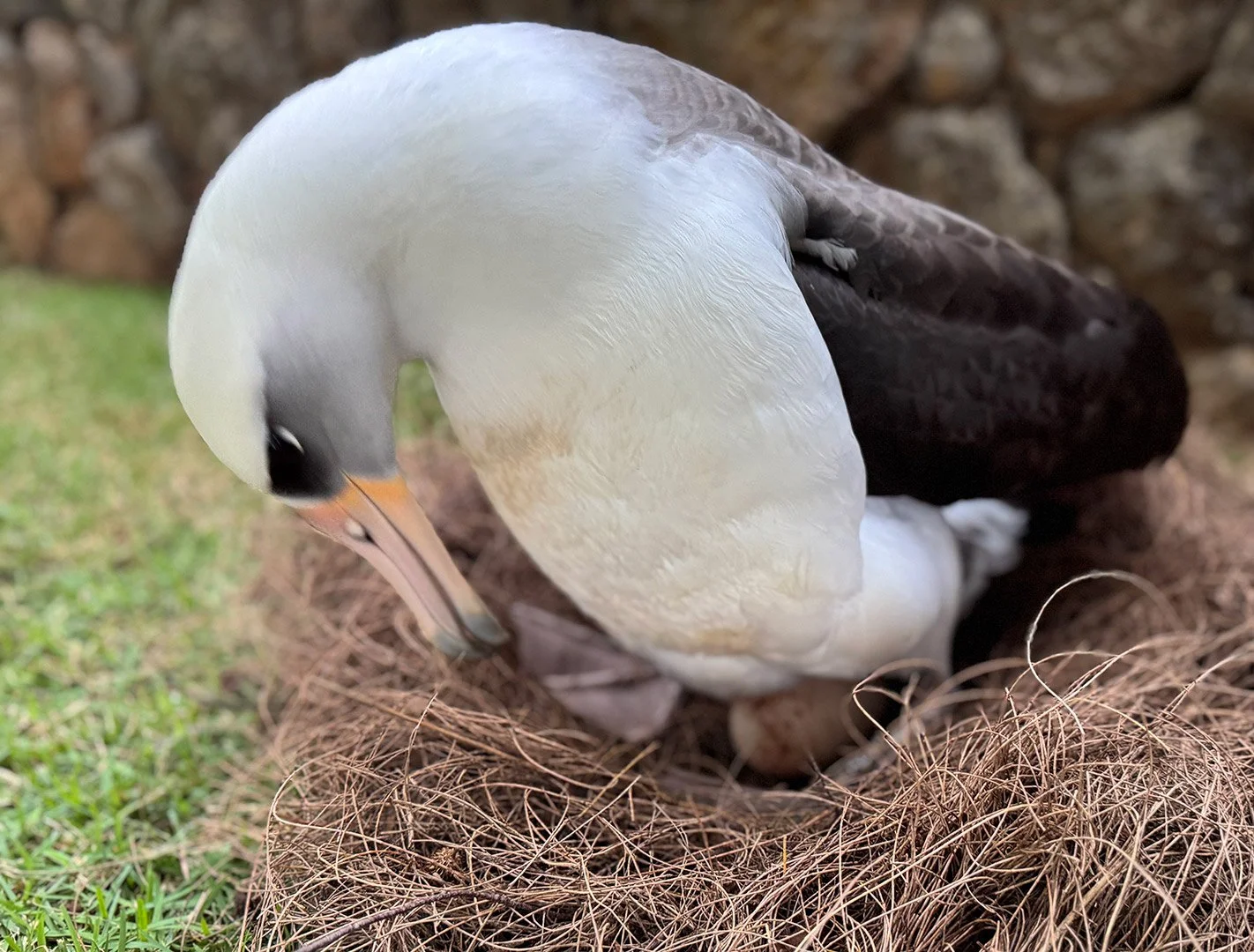Bumper Crop OʻTross - Kauaʻi Albatross Nest Count Up for 2025
By Safina Center Conservationist-in-Residence Hob Osterlund
A Laysan albatross colony at Kīlauea Point National Wildlife Refuge. ©US Fish and Wildlife Service
Mango is back!
OMG we know who Kalamaʻs mate is!
Henriettaʻs about to lay an egg and Sol is preening her!
Exclamation points launch like tiny rockets sent from one albatrossophile to another—and sometimes orbiting to multiple others—every November on Kauaʻi. Itʻs one of the grandest times in the nesting season for us: long-time mōlī mates reunite, which of course means that both birds have surivived at sea. They run to each other, eeping and chirping. They stand on tiptoes and whinny and moo, they scratch each otherʻs necks, they have sex. They snuggle, they preen, they spend the night together, they mate again. If anyone has ever doubted that birds are capable of love, convincing evidence can be easily gathered at a mōlī reunion.
Of course there are also those birds whose mates donʻt return. Such presumed widows and widowers might sit quietly at their previous nest sites. They might wander around and preen other birds—as if they offer themselves encouragement by the act of encouraging others—or to check whether they have accidentally overlooked their beloved. Males, with their restless hormones, might hit on just about any other solitary bird.
But this year, AKA “Hatch Year (HY) 2025” has been good so far. We have an estimated 388 nests, a first-place photo finish with 2018, when there were 392 nests. Of those, thirty-nine percent (153 nests) are on US Fish and Wildlife Service (USFWS) federal land at Kīlauea Point National Wildlife Refuge. Sixty-one percent (235 nests) are on private lands. Private land colony sizes vary from as few as one nest to as many as 63 nests.
2025 nesters. ©Angela Serota
As in most mōlī colonies, certain birds tend to stand out. Since they all look alike, you canʻt tell by their appearance.You can recognize them by their band numbers, by observing their relationships, and by witnessing their adaptations over a period of years.
Mango
As a co-star of the Cornell Lab of Ornithology “TrossCam” (2014), Mango is one of the two first mōlī chicks whose early life has ever been witnessed via livestream by international viewers. Mango fledged in July of 2014 and safely returned to his natal nest area five years later. Heʻs been seen regularly each season since then, but we have never seen him pick a mate. This year he surprised us with a nest, so weʻre on pins and needles to find out who the female is who actually laid the egg he shares.
Mango resting on his egg. ©Hob Osterlund
Kalama
Kalama is the first two-mom mōlī starlet of Kauaʻi. Other than Mango, her lifecycle has been visible to the viewing public longer than any other Laysan albatross. She hatched in 2017 in view of the TrossCam and was livestreamed twenty-four hours a day until several months later when she moved off camera to fledge from a nearby bluff. Kalama came from a translocated egg from the Pacific Missile Range Facility where nests are discouraged due to the danger of bird-aircraft collisions. She was raised by two adoptive moms. We produced a Telly Award-winning short documentary about those first six months of her life. Once Kalama fledged, we did not see her again until 2022. In HY2024 she became the youngest nester in her colony, but that egg broke soon after being laid. This year (HY2025) we have confirmed her mate (ʻEleu), and together they have chosen a better (shadier, softer) nest site. Their egg has officially been deemed fertile.
Stormy and Mr H
One Friday night in 2012 we got a call that a colony of ready-to-fledge mōlī chicks had been ravaged by loose dogs. We (Kim Steutermann Rogers, Jeanine Meyers and I) found a few chicks who were still alive. Not having enough kennels, we transported them wrapped in towels sitting on our laps or leaning into us. Save Our Shearwaters staff met up with us and agreed to admit five chicks into care. Four of those five survived. One of them was Stormy, so named because she had initially been head-bit and shocky, and looked unlikely to live. Then one night there was a big storm and she inexplicably woke up. She successfully fledged in 2012 and returned when she was only four years old. She became the youngest nester in her colony when she was six years old. Now Stormy has already outsurvived two mates. Last year she hooked up with “Mr H,” so named because of his previous fickle and, shall we say, horny behavior. Although we told her not to trust him, she knew better; Mr H turned into a model dad. Together they raised two very successful chicks (Hana Mana in HY2023 and Rico Suave in HY2024.) They now have another nest, but Stormy waited so long for Mr H to relieve her that she had to bail to go find food. He returned sometime between one to three days later. Has that egg survived? Time will tell.
Stormy resting on her egg. ©Hob Osterlund
Eddieʻs parents Sol and Henrietta
Sol was banded as a chick on Kauaʻi in 1994, making him one of Kauaiʻs oldest known nesters. His long-time mate was banded as an adult in 2003, so her age is unknown—but sheʻs likely at least 25 years old. They have been raising chicks for years, but they really got our attention in HY2023 when theirs was the first egg in the colony to hatch. And an auspicious day it was, since that same day the wildly popularly Eddie Aikau Big Wave Invitational Surf Meet was held on Oʻahu. So naturally their chick was named Eddie, a babe that proved to be quite gregarious and adventuresome. At that point Sol and Henrietta also got named, after the human parents of hero lifegaurd Eddie Aikau. As fate would have it, we learned several months later that Eddie was female. We opted not to change her name. Sol and Henrietta took the season off in 2024, but this year are tending another egg. After she laid it, Sol incubated the egg from November 22 until December 23, fasting all the while. Obviously we were delighted to see Henrietta return. And we hope for another inimitable chick, this sibling of the remarkable Eddie.
Stand by for updates.





